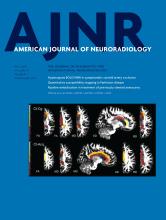Abstract
BACKGROUND AND PURPOSE: For the postoperative follow-up in pediatric patients with Moyamoya disease, it is essential to evaluate the degree of neovascularization status. Our aim was to quantitatively assess the neovascularization status after bypass surgery in pediatric Moyamoya disease by using color-coded digital subtraction angiography.
MATERIALS AND METHODS: Time-attenuation intensity curves were generated at ROIs corresponding to surgical flap sites from color-coded DSA images of the common carotid artery, internal carotid artery, and external carotid artery angiograms obtained pre- and postoperatively in 32 children with Moyamoya disease. Time-to-peak and area under the curve values were obtained. Postoperative changes in adjusted time-to-peak (ΔTTP) and ratios of adjusted area under the curve changes (ΔAUC ratio) of common carotid artery, ICA, and external carotid artery angiograms were compared across clinical and angiographic outcome groups. To analyze diagnostic performance, we categorized clinical outcomes into favorable and unfavorable groups.
RESULTS: The ΔTTP at the common carotid artery increased among clinical and angiographic outcomes, in that order, with significant differences (P = .003 and .005, respectively). The ΔAUC ratio at the common carotid artery and external carotid artery also increased, in that order, among clinical and angiographic outcomes with a significant difference (all, P = .000). The ΔAUC ratio of ICA showed no significant difference among clinical and angiographic outcomes (P = .418 and .424, respectively). The ΔTTP for the common carotid artery of >1.27 seconds and the ΔAUC ratio of >33.5% for the common carotid artery and 504% for the external carotid artery are revealed as optimal cutoff values between favorable and unfavorable groups.
CONCLUSIONS: Postoperative changes in quantitative values obtained with color-coded DSA software showed a significant correlation with outcome scores and can be used as objective parameters for predicting the outcome in pediatric Moyamoya disease, with an additional cutoff value calculated through the receiver operating characteristic curve.
ABBREVIATIONS:
- AUC
- area under the curve
- CCA
- common carotid artery
- ΔAUC ratio
- adjusted area under the curve changes
- ΔTTP
- difference between preoperative and postoperative time-to-peak
- ECA
- external carotid artery
- EDAS
- encephaloduroarteriosynangiosis
- MMD
- Moyamoya disease
- © 2016 by American Journal of Neuroradiology












